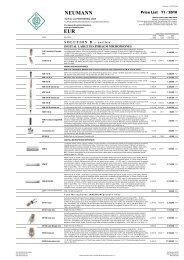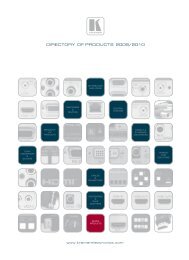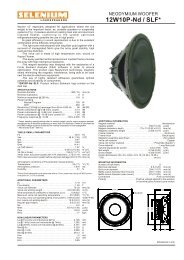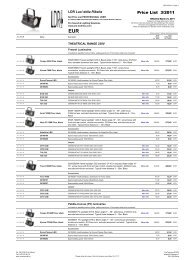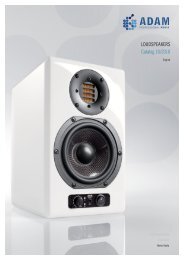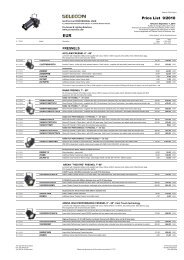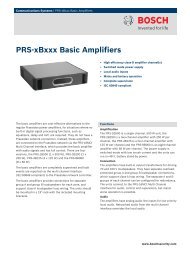Download - Yamaha Downloads
Download - Yamaha Downloads
Download - Yamaha Downloads
You also want an ePaper? Increase the reach of your titles
YUMPU automatically turns print PDFs into web optimized ePapers that Google loves.
Case Study #13<br />
Case Study #14<br />
White Mobile - Amek & Vanis<br />
(Modena, Italy)<br />
Mizuno Classic,<br />
Mainichi Broadcasting System, Inc.<br />
(Osaka, Japan)<br />
OB Van / Processor<br />
The Amek & Vanis White Mobile is a large outside-broadcast van<br />
optimized for the recording and broadcasting of music events.<br />
Within this van, a <strong>Yamaha</strong> DME24N is used for audio processing<br />
and the selection of a range of monitoring signals in 5.1, 3.1,<br />
Stereo+Sub, 2.0, and other formats.<br />
A bank of twelve AD824s receives signals from outside sources,<br />
converts them into ADAT format, and then routes them to a pair<br />
of DM2000V2s configured in cascade mode. From these digital<br />
production consoles' OMNI OUTs, the signals then go to the<br />
DME24N, where they are processed and distributed to the van's<br />
monitor speakers. And using a homemade GPI box integrated<br />
with the DME, stored scenes and configurations can be easily<br />
and rapidly recalled whenever needed.<br />
Interface / CobraNet Network<br />
Using a number of NHB32-C interface units, Mainichi<br />
Broadcasting System (MBS) of Osaka, Japan digitally transfers<br />
audio via CobraNet as part of its relay broadcasting of golf,<br />
road races, and other sporting events. For example, at the<br />
Mizuno Classic, held in November 2007, the broadcaster used<br />
CobraNet to transfer no less than 96 channels of audio<br />
between an outside audio broadcasting van and a relay<br />
center.<br />
Le Cercle Rouge (TSF)<br />
(Paris, France)<br />
The TSF group, founded by Thierry de Ségonzac, is the<br />
European leader in its field, supplying cinema and television<br />
production companies with everything they need for<br />
production. In fact, seventeen of the films at this year’s<br />
Cannes Film Festival were shot using TSF equipment.<br />
When, early in 2007, TSF moved into a new, customized<br />
building, Thierry de Ségonzac decided to build a state-of-art<br />
projection room for 35-mm and 2K (soon to be 4K)<br />
projectors. In Le Cercle Rouge, de Ségonzac successfully<br />
achieved the "no compromise" room that he had been<br />
seeking. Located on the second floor of the TSF building, it<br />
features 126 Club Class seats and an 11.2-meter wide screen<br />
in 2.35:1 format. To obtain the best possible sound and image<br />
quality, de Ségonzac placed his trust in the ShowMax process<br />
approved by acoustics engineer Pierre Vincent. Image quality<br />
is already impressive in 2K digital cinema, and the even<br />
higher quality 4K format is just around the corner.<br />
At the heart of the audio installation is a <strong>Yamaha</strong> DME64N<br />
processor operating at 24 bits/96 kHz to guarantee<br />
uncompromising audio quality. "In my first systems”, explains<br />
Pierre Vincent, “I had used a different digital processor from a<br />
highly respectable manufacturer, but as soon as I changed to<br />
the DME64N, the improvement in audio quality was obvious.<br />
As far as I know, the DME is the only HD compliant digital<br />
audio processor available today that's capable of processing<br />
eight channels at 24/96 in accordance with the recommendations<br />
of the Digital Cinema Initiative (DCI)."<br />
The DME64N at Le Cercle Rouge works continuously at more<br />
than 90% of its processing capacity. It is responsible for<br />
32x32 grid functions, room compensation (X curve), and<br />
active three-way bass/mid-range/treble filtering for all the<br />
front channels and the delay (essential for digital cinema).<br />
The digital mixing engine is fitted with two digital input<br />
boards providing sixteen channels, and one of these is<br />
allocated to the HD projector's digital server. In addition,<br />
Surround & Processor<br />
ShowMax Screen and DME64N<br />
On its recent move to larger premises, the French cinema image and lighting-equipment hire group TSF built a<br />
large "no compromise" projection room with the aim of full compatibility with traditional film and high-definition<br />
video. The room – known as Le Cercle Rouge – features an 11.2-meter screen and a 16-kW ShowMax soundreproduction<br />
system built around a <strong>Yamaha</strong> DME64N Digital Mixing Engine.<br />
sixteen analog input channels are provided by two further<br />
boards, one of which receives the output from the Dolby<br />
Digital CP650 processor.<br />
As the room must adapt to different sound-mixing standards<br />
(5.1, 6.1, etc.) and the ten surround enclosures must switch<br />
their sources accordingly, the DME64N also manages sixteen<br />
different outputs. This has been easily realized by storing the<br />
corresponding configurations within the DME, and a<br />
conference preset has even been setup for times when Le<br />
Cercle Rouge is used for this purpose. Furthermore, Vincent has<br />
also configured the DME such that the room's overall sound<br />
level can be controlled using the data wheel on the front panel.<br />
As a result of this uncompromising approach, sound reproduction<br />
in the room is amazing – far better than that in many<br />
commercial cinemas. The bass seems to be unlimited, dialogue<br />
has a rare precision and intelligibility, and the spatialization is<br />
faultless. Even so, Pierre Vincent has more ideas for improvement:<br />
"I am currently testing <strong>Yamaha</strong> amps in the Tn range as<br />
they are said to be particularly suitable for this type of<br />
installation".<br />
27 28<br />
Case Study #15



